CAA News Today
In Memoriam: Robert Farris Thompson
posted by CAA — December 10, 2021

Robert Farris Thompson, an eminent art historian recognized for his field-leading research and writing on the art, history, culture, dance, and music of Africa and the Afro-Atlantic world, and who was the longest serving head of college in Yale’s history, died on Nov. 29. He was 88.
Thompson was professor emeritus of African American studies and the former Colonel John Trumbull Professor of the History of Art at Yale. For more than a half-century on Yale’s faculty, and during his 32 years as “Master T” at the helm of Timothy Dwight College, he secured his place in the pantheon of beloved professors and university leaders.
In recognizing Thompson with its inaugural Distinguished Lifetime Achievement Award for Writing on Art in 2003, the College Art Association described him as a “towering figure in the history of art, whose voice for diversity and cultural openness has made him a public intellectual of resounding importance.” In May 2021 he was honored with an honorary degree from Yale celebrating his lifetime of academic achievement.
Above excerpts and image from, “Robert Farris Thompson, pioneer in study of African and Afro-Atlantic art,” YaleNews (December 1, 2021). Please click this link to read the full article.
In Memoriam: Julie L. Green
posted by CAA — November 04, 2021
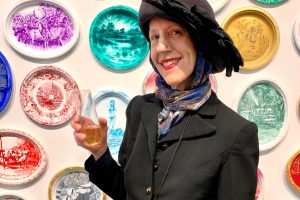
Artist Julie Green in front of one of their pieces in The Armory Show 2020, which included a salon-style presentation of Fashion Plate works, painted on Chinet plates and platters. (Photo by Theo Downes-Le Guin/Upfor Gallery)
Artist and educator Julie Green died at home on Tuesday, October 12, 2021. Green (who preferred gender neutral pronouns) was diagnosed with ovarian cancer nearly two years ago.
Julie Lynn Green was born in 1961 in Yokosuka, Japan to Frederick William (Bill) Green and Jane Green. Green’s birth wasn’t without excitement: their father was airlifted by helicopter off a Navy ship to support Jane during pregnancy complications. Both mother and child were fine. As a child, Green lived in Washington State, Ohio, New Jersey, Illinois, and Iowa, where they attended Des Moines Roosevelt High School, graduating in 1979. From an early age, Green shared their mother’s passion for creative projects, thriving as an artist and performing with a high school mime group. One of Green’s favorite pastimes was to play Scrabble with grandmother “GrandMary.” In 1995, Green married longtime partner Clay Lohmann, who encouraged a lifelong interest in yoga and expanded Green’s artistic pursuits.
Green wrote that they wanted to be a stewardess until age four, but became a painter instead. Green received a B.F.A. and M.F.A. from The University of Kansas, studying with noted artist Roger Shimomura, who remained a lifelong mentor and friend. Green joined the faculty at Oregon State University in Corvallis, Oregon in 2000 as a professor in the Art and Art History Department. While garnering admiration and affection from a generation of students, Green also maintained an active studio practice. Green started their best-known work, a series of paintings on second-hand plates depicting the last meal requests of death row prisoners titled The Last Supper, in 2000. A few weeks before their death, Green decided to end the project at 1,000 plates. The first 800 plates are currently on view at the Bellevue Arts Museum in Bellevue, Washington.
Green worked in a variety of mediums but identified primarily as a painter, often combining humble materials and techniques with art historical traditions. Green painted on linens, Tyvek, and Chinet-brand paper plates as well as paper and canvas, with pigments from sources as diverse as industrial waste byproducts, rare earth elements and 7UP. Awarded a Hallie Ford Fellowship in the Visual Arts from The Ford Family Foundation, Green’s accolades also included grants and fellowships from the Oregon Arts Commission, the ArtPrize 3-D Juried Award, and a Joan Mitchell Foundation Painters and Sculptors Grant. Green’s work was featured in a variety of publications and programs including The New York Times, Rolling Stone, NPR, and PBS, and was exhibited widely in museums and galleries throughout the United States. Green’s final public exhibition in their lifetime, at The Armory Show in New York in 2020, garnered the Presents Award.
Green was preceded in death by their father Frederick WIlliam Green. Green is survived by their husband, artist Clay Lohmann, brother Scott Green, and mother Jane Hamilton.
–Theo Downes-Le Guin and Scott Green
Remembering Rick Asher
posted by CAA — July 13, 2021
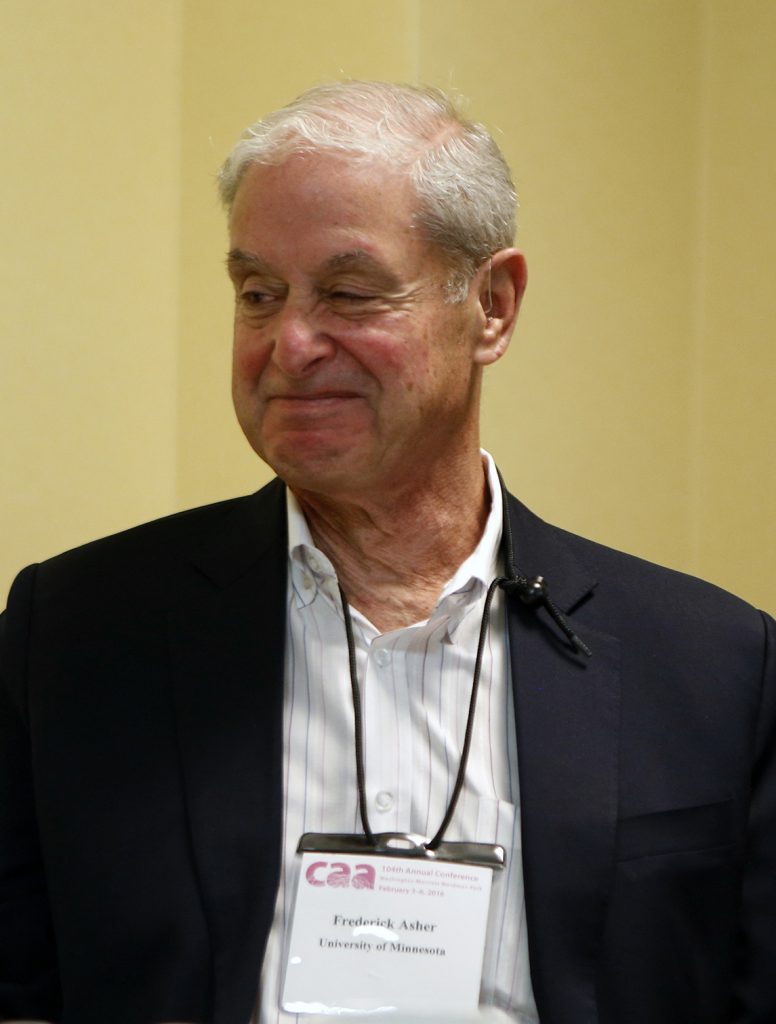
Rick Asher. Photograph by Ben Fractenberg.
Frederick M. Asher, beacon of collegiality and builder of institutions, died on June 26, 2021, having turned 80 just one month earlier. His generosity of spirit guided many scholars through their graduate years and beyond: at the University of Minnesota, where he spent his academic career, and around the world. With Catherine B. Asher, his wife and fellow historian of South Asian art, he led initiatives to document and preserve images of art, archaeological, and architectural objects and sites in India; mentored numerous colleagues and students; and contributed his energies to making academic organizations flourish across the world. He was an early, active member of the American Council for Southern Asian Art (ACSAA); served as president of the American Institute of Indian Studies; and played many roles at CAA, most recently as part of the CAA-Getty International Program where his energies encouraged many of us to reach out across physical and intellectual distances to begin new conversations.
His early research, published in 1980 as The Art of Eastern India, 300–800 (Minnesota), draws connections across the Gupta and Pala eras, thinking deeply about continuities across media—terracotta, bronze, and stone—and across belief systems. His subsequent research led him to study contemporary sculptural practices as a way of understanding the work of unnamed historical sculptors and to a deep engagement with the materiality, crafting, and afterlives of both sculptural objects and the sites where they were worshipped and excavated. His final book, Sarnath: A Critical History of the Place Where Buddhism Began (Getty 2020), published just months before his death, focused on the place where the historical Buddha preached his first sermon, tracing the establishment, excavation, and reimagining of the monastic site from that founding moment to the present. In April, Rick discussed the book with James Cuno for a Getty podcast, giving us a glimpse into his intellectual process and offering many of us a reminder of the rhythms of his class lectures. With his students, Rick always ran toward questions and tantalizing bits of information, wondering at what we don’t know about the past and at the same time marveling at contemporary uses of ancient sculptures and sites. At Sarnath, this meant both the tourists shuttling in from Varanasi with their local guides (guides who almost certainly had met Rick and discussed their mutual love of the site with him) and the international monastic Buddhist communities with pilgrimage centers nearby. Rick cared deeply about his students, and his engaging, dynamic teaching was renowned. He received the University of Minnesota’s Morse-Alumni Undergraduate Teaching Award in 2005–2006, one of his most treasured moments of recognition.
I was incredibly fortunate to visit Sarnath for the first time with Rick and Cathy as part of a trip they organized for the cohort of graduate students in the late 1990s. The trip was exemplary of the Ashers’ generosity and openness—recognizing the hurdles associated with pursuing academic research in India, they sought to pass on their extensive experience by offering us the opportunity to shadow them in their respective projects. Rick had been working with a scientist at the University of Minnesota to ascertain the locations of quarries for various Pala-era (8th–12th century) sculptures by matching stone samples. The project focused on both the materiality and the process of crafting the sculptures—he considered how stone was separated from the earth, how it would have been chosen for a sculpture, and then how it was carefully carved with the detailed iconographies of a Vishnu or a Tara.1 The project’s success relied on his ability to bring people together in a common project: Rick recruited curators and conservators at museums around the world to undertake the delicate process of excising a thin section from the back of these sculptures to compare to the samples he gathered from quarries in Bihar and Bengal. It was this latter piece of the project that he embarked on that summer, taking two of us green graduate students with him into remote areas of Bihar, where we stayed in dak bungalows (remnants of the nineteenth-century postal system) and revisited many of his early research sites from his own graduate days. Rick’s enthusiasm for reconnecting with the people of the region and introducing us to them still resonates with me today, guiding my own fieldwork experiences beyond the inert object to understand the deep interconnections between art, history, and the people who made and continue to interact with the “works of art” we study, works that remain very much alive in the present.
Rick had an incredible gift for open and positive leadership. He hosted ACSAA’s first conference in 1981, and he made sure that the group served as a space of warm, collegial exchange as it grew over the decades. He attended every conference, symposium, workshop, and meeting, seeking out the panels where colleagues and former students were presenting. He would often ask the first question, to draw out commonalities across a diverse panel and also, I came to realize, to facilitate discussion and to give everyone else in the audience time to formulate their own questions. It was primarily at conferences that he would make connections between scholars, a kind of academic matchmaking, if you will. One of the truths of my academic life is that if we have met, Rick probably introduced us. He would stride over, beaming, happy to see you, and then almost immediately say, “there’s someone here you should meet.” Then he would bound off, urging you to follow, to joyfully connect you to a towering senior scholar or newly minted PhD, offering a few choice intellectual threads to solidify the link. Rick understood that the big institutions—CAA prominent among them—only worked because of the dedication of an interconnected group of individuals who recognized their shared commitment to the field. These introductions wove the fabric of these institutions such that when he passed, my email inbox was filled with loving notes and remembrances from colleagues around the world—his colleagues, and also, because of him, my colleagues.
Rick, whose intellectual pursuits focused on the material connections between works of art and people and who cared deeply for makers of objects and sites and the ways in which places and people shaped one another over time, thus continues to connect us even at the moment of his passing. His own post-history has yet to be written, but I have a strong feeling that his energy and presence will be with us at each future academic meeting, in each future encounter. So wonderful to see you! Come, there’s someone here you should meet.
–Rebecca M. Brown, Johns Hopkins University
In Memory of Moira Roth
posted by CAA — June 29, 2021
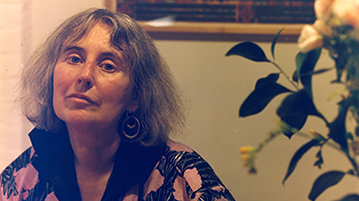
Moira Roth, photo by Max Kozloff, courtesy of Sue Heinemann
Moira Roth, one of the last of the founding generation of feminist art historians, died on June 14, 2021, at the age of 87. Famously warm, gracious, and charming, Roth was an outsized figure in progressive art history who treated internationally celebrated artists and her Mills College undergraduates with equal solicitousness and respect. Despite a perfectly preserved British accent after over fifty years in the US, she identified with outsiders, chiefly those who stood as the obverse of her own origins, e.g., African Americans, Jews, queers, Asian Americans—the women among them most of all. Persistent and profoundly subversive, she could electrify: at a conference on John Cage shortly after his death, amidst a welter of traditional academic papers, Roth simply read the day’s New York Times front page, a perfectly Cageian act that at once brilliantly distilled his aesthetic politics and echoed his repeated attempts to link his art with a larger politics of power and control.
A pioneering figure in multiple fields, Roth cofounded, with Flo Oy Wong and Betty Kano, the Asian American Women Artists Association (AAWAA) in San Francisco and wrote one of the earliest articles in queer studies in art history, her celebrated 1977 “The Aesthetic of Indifference” about the queer post–Abstract Expressionist generation of Johns, Rauschenberg, Cage, etc. That article became, for me and many others, a singular intellectual touchstone, demonstrating not only that a queer art history was possible, but that taking sexuality seriously offered up a new and powerful lens to the field. Equally precocious was her The Amazing Decade: Women and Performance Art, 1970–1980, an important archival resource published in 1983 that also anticipated the development of a new field. Roth was a scholar, a celebrated interviewer of artists, a poet, performance artist, and dinner host extraordinaire. Long after the era of Bay Area communes, friendship for her was something she took very seriously—a way of being in the world in close communion and interdependence with the like-minded, creating a coalition of mutual support and activist change.
Roth’s generosity was legendary, with students, colleagues, and artists alike. Those of us lucky enough to be invited to dinner would find a beautifully set, colorful table, always water in blue bottles, a written menu of dishes lovingly wrought from the wonders of Berkeley’s farmers’ markets, and Roth at her most wistful; indeed, dinners were often moved back in time and place to reflect her current imaginative engagements. The twinned currents of her life, friendship and scholarship, often intertwined, and artists, scholars, and students were frequent dinner guests in her Berkeley home with its laden lemon tree right by the door. Her generosity toward younger scholars knew no bounds, and she generously promoted their work to editors seeking her contribution. When she was approached about publishing a volume of her early work on the post–Abstract Expressionist generation, she asked me to contribute a critique of her early works from a queer studies perspective, knowing full well that as much as I loved her early writing, I also felt it didn’t go far enough in its queer analysis. The book that resulted from that astounding act of generosity, Difference/ Indifference: Musings on Postmodernism, Marcel Duchamp and John Cage, was couched less as a tribute to her historical import and more as a present-tense debate over politics and methods—a classically Roth move to all who knew her.
Roth was an artist in her own right, doing performances, writing short stories and poems, traveling the world to offer up criticism while exploring new national cultures. Her investigation of the world of Rachel Marker was a thinly disguised imaginative re-creation of the pre-Holocaust context of her “other” mother, Rose Hacker, a remarkable feminist politician in the UK who first entered Roth’s life as a Jewish refugee from the bombings in London and entranced her with her bold refusal to submit to gendered expectations and codes. Roth was also effectively the founder of a new performative approach to art history, stressing work done in collaboration, often across widely dispersed national boundaries. Her gift of uniting disparate communities and forging powerful connections among people who previously didn’t know one another remains in evidence today. Among the many artists with whom she collaborated, either on writing projects or performances, were Faith Ringgold, Suzanne Lacy, Carlos Villa, Pauline Oliveros, Rachel Rosenthal, and Dinh Q. Lê.
Roth received a Lifetime Achievement Award from the Women’s Caucus for Art in 1997 and a National Recognition in the Arts Award from the College Art Association in 2006. She was interviewed by Sue Heinemann for the Smithsonian Archives of American Art Elizabeth Murray Oral History project.
Remembrance by Jonathan D. Katz, University of Pennsylvania
In Memoriam: Roland Reiss
posted by Allison Walters — January 12, 2021
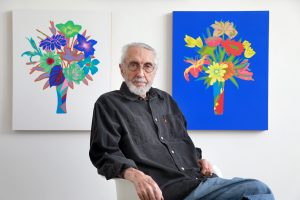
Roland Reiss in front of by Unrepentant Flowers (April 2018), photo by Eric Minh Swenson
We are deeply saddened that Roland Reiss, whose practice spanned Abstract Expressionism, the plastic arts, and representational painting, died on December 13 in Los Angeles at the age of ninety-one.
Jorin Bossen has spoken on the life and career of Roland Reiss:
“Roland saw everything through the lens of art. Even in his last year he produced stacks of drawings each week examining the simple proposition of a circle positioned next to a square. This investigation of thought and possibility extended into the way that he undertook teaching. Teaching was an interactive process—an exchange of ideas. He knew how to point his students in the general direction we needed to be heading. Through new techniques, unfamiliar materials and mediums, seemly-unrelated exercises, and personal chats students often found ourselves in new and unexpected artistic territory. One that we didn’t know existed but filled us with hope, fear, and excitement. For Roland teaching was art.”
In Memoriam: Robert L. Herbert
posted by Allison Walters — December 22, 2020
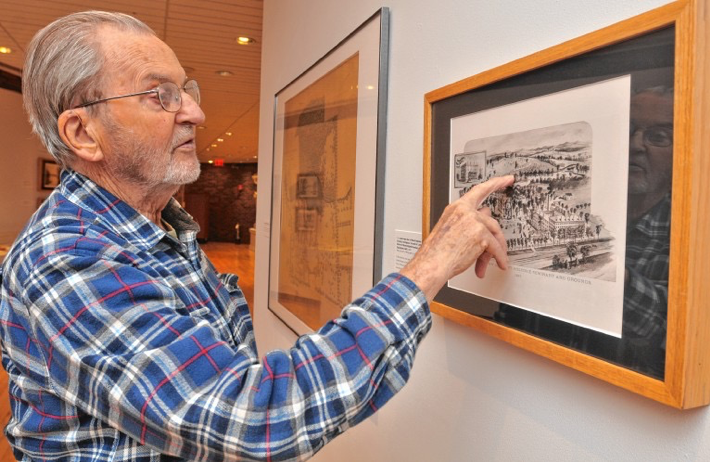
Robert L. Herbert
We are saddened to learn of the passing of Robert L. Herbert, a visionary in art history and extraordinary teacher to many. He received CAA’s Distinguished Lifetime Achievement Award for Writing on Art in 2008. He passed December 17 of a stroke at 91.
Robert L. Herbert
In an extraordinary career spanning more than sixty years, Robert L. Herbert was remarkably consistent in a practice that has come to define the social history of art, which he described as “the moral and passionate … search for what paintings and drawings meant in the artists’ time.”1
As an undergraduate at Wesleyan University in the late 1940s and early 1950s, he was fascinated by the history of science, an interest that encouraged his study of color theory in his dissertation on the nineteenth-century French artist Georges Seurat, completed at Yale University under the direction of George Heard Hamilton in 1957. By that time, Herbert had already been inspired by the work of Meyer Schapiro, who encouraged his lifelong commitment to socialism as a framework for political and intellectual development. Proud of his roots in a working-class New England family, Herbert resisted the formalist bias of his training, although he readily acknowledges a debt to those who taught him to look carefully at works of art and to appreciate the importance of technique and pictorial structure. From the beginning he always insisted that “the stuff of ordinary daily life should enter into art history,” and made it his goal “to restore the flesh of real painters and their culture to the bones of style and form.”
A desire to balance respect for the artist’s distinctive modes of representation with a socially and historically grounded reading of subject matter was a salient feature of Herbert’s research, which focused, for example, not only on the color and facture of paintings by Seurat and other Neoimpressionist artists, but also on the distinctive subject matter and the politics of their art. Recognizing that the prevailing view of Seurat tended to privilege his large-scale paintings, Herbert trained attention on his drawings in a book published in 1963; yet he also continued to explore the meanings of Seurat’s paintings, organizing a major retrospective exhibition on the hundredth anniversary of the artist’s death in 1991 as well as another, Seurat and the Making of “La Grande Jatte,” that was devoted to his most celebrated painting in 2004. In fact, many of Herbert’s most innovative and important contributions to the history of art have been made in the context of exhibitions, which require careful attention to individual objects in addition to the presentation of a unifying conception of the whole. For his first foray into this genre of scholarship, the 1962 exhibition Barbizon Revisited, Herbert wrote a catalogue that won CAA’s Frank Jewett Mather Award and precipitated a renewed appreciation of the work and historical significance of mid-nineteenth-century landscape painters such as Corot, Millet, and Rousseau, among others. His ambition for the exhibition was expressed in terms that convey his dedication to a particular kind of art-historical practice: “The purely historical treatment of art is bloodless. The real heritage of Barbizon art is in the paintings, and their vitality must be experienced in our viscera. Otherwise works of art are documents to be assessed, catalogued, and filed away. But there is a proper use of history, namely, to prod us into discoveries which release our imagination and permit us to rise to the realm of true poesis. An historical evaluation of Barbizon art will only have value if it succeeds in doing just this.”
Just as the study of Seurat’s drawings prompted Herbert to look carefully at Millet’s drawings and other work in articles and exhibitions of the 1960s and 1970s, so Seurat’s paintings eventually led him to the work of Fernand Léger, whom he considers to be Seurat’s descendant and a great practitioner of the craft of painting. Thus although Herbert’s scholarly reputation is bound to his work on nineteenth-century French painters—he has written books on Monet and Renoir, a survey devoted to the leisure subjects of the Impressionists, as well as the publications mentioned above on Seurat, Millet, and the Barbizon School—he has also produced significant scholarship on early-twentieth-century modernism. His first contribution to that field was an edited volume of ten essays, Modern Artists on Art, published in 1964. This was followed twenty years later by a detailed study of the large, diverse collection of European and American modernist art from the Société Anonyme that Katherine Dreier had bequeathed to Yale at midcentury and that Herbert had explored for many years together with his students. Along the way, Herbert developed research he had undertaken as a graduate student into a book, published in 1972, on David’s Brutus and its political significance in the context of the French Revolution; his commitment to the social history of art was also evident in a volume of selected art criticism by John Ruskin that Herbert edited in 1964 and for which he wrote an eloquent introduction that provided a thoroughgoing reevaluation of Ruskin’s significance from a variety of perspectives, demonstrating his acute relevance to the social history of art that Herbert was in the process of articulating at the time.
It is impossible to summarize Herbert’s contributions to art history simply in terms of his scholarly production, impressive as that output has been. He has also been an inspiring teacher of undergraduate and graduate students, setting an example in countless ways that go well beyond his commitment to scrutinizing original works of art alongside archival resources of the most diverse kinds. In addition to imparting these indispensable staples of the trade, he maintained an extraordinary level of personal and professional engagement with his students, loyally supporting their ambitions and celebrating their achievements, whether large or small. Refusing to be impressed by conventional measures of status, in 1990 he acted on his commitment to feminism by relinquishing his position at Yale in order to join his wife, Eugenia Herbert—whom he has always described as his greatest intellectual companion—on the faculty of Mount Holyoke College.
As professor emeritus and living in South Hadley, Massachusetts, he discovered a passionate interest in the life and work of a mid-nineteenth-century female botanist and illustrator named Orra White Hitchcock. “I’ve taken the plunge,” Herbert has remarked, “into the world of American women’s diaries, into travel diaries, and into the history of geology and the natural sciences, embraced in the broader spectrum of American social and cultural history of the middle third of the nineteenth century. It’s a new world for me, and I have no regrets at giving up French art history!” Subsequently he turned to exploring the history of Mount Holyoke and curated several exhibitions with James Gehrt and Aaron Miller.
He died December 17 of a stroke at 91 and is survived by his wife of 67 years Eugenia (Fi); children, Tim, Rosie, and Cathy; their mates, Mara, John and Chris; six grandchildren, and a wealth of friends to whom he was immensely devoted as well.
In Memoriam: Richard Brettell
posted by CAA — August 11, 2020
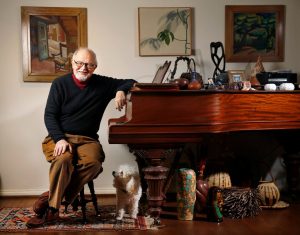
Dr. Richard (Rick) Brettell.
We were saddened to learn of the passing of longtime CAA member Dr. Richard Brettell last month at the age of 71. Dr. Brettell was a tireless advocate for the arts, a well-respected scholar, former director of the Dallas Museum of Art, and founding director of the Edith O’Donnell Institute of Art History at the University of Texas, Dallas. Read an remembrance by Jonathan D. Katz, Interim Director, Gender, Sexuality and Women’s Studies and Associate Professor of Practice in the History of Art at the University of Pennsylvania, below.
In Memoriam
Richard (Rick) Brettell died July 24, 2020 in Dallas after a long battle with prostate cancer—and entirely characteristically, he was working until the very end. A tireless advocate for the arts in general, for French Impressionism in particular and for Texas artists and the local cultural scene, Brettell spanned genres, chronologies, nationalities and professions with an acrobatic grace. He was a world class scholar, a museum director and builder, and above all a connector, of people to ideas, of money to institutions, of museums in France to museums in the US, of friends to other friends. Seemingly limitless in his capacity to extend friendship and take it up again, I’m sure there are legions out there who think Rick was their best friend. A man of sure and independent judgment, Brettell was as thrilled to bring attention to an underknown or even unsung artist as he was to Gauguin, and approached both with the same profound curiosity and boosterism.
A graduate of Yale University, Brettell’s dissertation on Pissarro set the pattern for the rest of his life. Once he became interested in something, he would not only write about it, he’d also work up an exhibition spotlighting it—in this case, the very first international Pissarro exhibition, curated when he was still quite young. He turned his enthusiasms into scholarship with a speed and assurance that suggested he saw no difference between the two modes. And the goal was always the same, to kindle the viewer’s own enthusiasm, to seduce close looking and careful thought and make art history, art criticism, and art appreciation one and the same.
Initially hired as a professor at the University of Texas, in 1980 Brettell left Texas to become the Searle Curator of European Painting at the Art Institute of Chicago. Renovating and reinstalling the Art Institute’s vast European art collection hardly impeded the string of notable international exhibitions he curated, most centrally the one that earned him the honor of being named a Chevalier (Arts et Lettres) by the French government: A Day in the Country, Impressionism and the French Landscape. Because Brettell traveled in some of the most rarified circles in the country, his genuine friendships with some of the country’s wealthiest citizens made him a rainmaker in a class by himself. When he was a curator at the Art Institute of Chicago and I was still a grad student, I remember visiting him at the museum to ask about the whereabouts of a specific Gauguin painting, the subject of a paper I was assigned. Rick reached down to the safe at his feet, opened it, pulled it out and nonchalantly asked, “this one?”
In 1988, Brettell moved to Dallas to become the McDermott Director of the Dallas Museum of Art. There he continued to develop important international exhibitions—including a new emphasis on the arts of Latin America and Africa—while also raising the funds to build a major new wing. In 1998, Brettell became the Margaret McDermott Distinguished Chair in Art and Aesthetic Studies at the University of Texas, Dallas (UTD). He would soon transform UTD, bringing in such transformational gifts as a huge endowment to build the Edith O’Donnell Institute of Art History. With the assistance of Margaret McDermott, in 2017 Brettell created a $150,000 bi-annual lifetime achievement in the arts award, The Richard Brettell Award in the Arts. The following year, he acquired the Barrett collection of Swiss art for UTD, consisting of 400 works, including a large percentage by the Swiss 19th/early 20th-century master Ferdinand Hodler. And last year, he helped UTD acquire the extensive Crow Collection of Asian Art, along with 23 million dollars to build a new museum, the second for the collection, on campus. A lifelong student of architecture, he helped to found the Dallas Architecture Forum. Many doubtless fondly remember his loud, enthusiastic, no holds barred architecture tours, where he would alternately vigorously praise and vehemently excoriate architects, and the houses and institutions they built.
Brettell was the author of numerous books and catalogs, including the editor of the forthcoming Gauguin catalogue raisonné. As a leading international specialist in French art history, he joined forces with his friend Elizabeth Rohatyn, then the wife of the Ambassador to France under Clinton, and Françoise Cachin, former Director of the French National Museums, to found an organization called FRAME (French/Regional/American Museum Exchange). He directed this project in cultural diplomacy bringing together twelve French and twelve American museums to cooperatively share works and develop exhibitions. For this effort, he was named a Commandeur in the French Order of Arts et Lettres. For decades, Brettell was loyally assisted by Pierrette Lacour, who shared his grand visions, but was rather more attentive to the nuts and bolts work of bringing them about.
Immensely erudite, opinionated, and frank, Brettell would assert that fame was no barometer of quality. He loved complicated, intelligent work regardless of the artist’s standing. He boosted Texas artists in general, and none more so than James Magee, an artist he frequently called the most underrated in the country. He was central to the ongoing effort to protect Magee’s extraordinary project in the desert outside of El Paso, The Hill, a hand-built mytho-poetic compound that has taken the bulk of Magee’s artistic life.
A famous raconteur, fabulous cook, witty tour guide, emotional lover of beauty and gossip, Brettell was roundly adored. He leaves behind his wife Caroline, his 94 year-old mother, his assistant Pierrette, and legions on every continent who basked, however briefly, in the warmth of his attention. A celebration of his life will be held at a later date. But those who wish to remember Brettell are encouraged to make donations to the University of Texas at Dallas’ Richard Robson Brettell Reading Room in the future UTD Athenaeum, which Brettell helped conceive.
Remembrance by Jonathan D. Katz.
In Memoriam: Cynthia Navaretta
posted by CAA — June 15, 2020
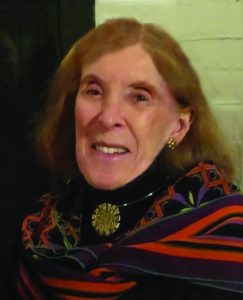
Cynthia Navaretta.
We were saddened to learn of the passing of critic, publisher, and longtime CAA member Cynthia Navaretta last month at the age of 97. An active member of the organization and a founding member of the Women’s Caucus for Art (WCA), Navaretta was founder of the feminist arts publisher Midmarch Arts Press and a tireless advocate for women artists.
A memorial in her honor will be hosted via on Sunday, September 13th, 2020, at 6pm (EST). Members interested in attending are invited to contact cyncelebration@gmail.com to receive information and a link closer to the event. Readers are also invited to post comments and pictures about her life on a newly created Facebook page, here.
Cynthia Navaretta, art critic, curator, publisher, art collector, architectural engineer died on May 18, 2020 at 97
In her mid-twenties Cynthia Navaretta was immersed in the New York art scene from the early days of the ‘New York School’ and the influential “8th Street Club” (one of only 6 female members!) before she married Emanuel Navaretta, artist, poet, critic, professor and roommate of Franz Kline in 1950. Cynthia’s friends and neighbors in New York and Long Island (Springs in the Hamptons) included Jackson Pollack, Harold Rosenberg, Lee Krasner, Milton Resnick, Milton Avery, Franz Kline, the De Kooning’s (Elaine and Willem) Ibram Lassaw, David Smith, Phillip Pavia, Judy Chicago, Agnes Martin, Pat Passlof, Hans Hofmann, June Wayne, Susan Schwalb and a long list of other art legends.
In 1974, she was a founding steering committee member of ‘Artists Talk On Art’, the art world’s longest running panel discussion series. With her knowledge of the New York art scene, along with her professional qualifications in engineering and building, Cynthia served as a mayoral appointee to the Artists Certification Committee of the NYC Department of Cultural Affairs and later served as the public voting member of the powerful Loft Board in Manhattan for 20 years, deciding who was a bona fide artist and deserving of live-work studio space in converted factories. She was a founding member of the Women’s Caucus for Art, the Coalition of Women’s Arts Organizations, and also Women in the Arts.
She represented the United States at the 1985 UN Conference on Women in Kenya and served in similar capacities on other boards and meetings around the world including the International Festival of Women Artists, Copenhagen in 1980. She befriended many well-known African-American women artists throughout the United States. In 1995, she published the first definitive compendium of American women artists of color – Gumbo Ya Ya: Anthology of Contemporary African – American Women Artists with an introduction by Leslie King Hammond, Midmarch Arts Press.
As the founder of Midmarch Arts Press, she published numerous memoirs, guides, histories and anthologies by and about American artists, male and female including: Guide to Women’s Arts Organizations, Women Artists of the World edited by Sylvia Moore, Cindy Lyle and Cynthia Navaretta, Mutiny in the Mainstream — Talk That Changed Art (with Judy Seigal), The Heart of the Question, The Writings and Paintings of Howardena Pindell, introduction by Lowery S. Sims, Voices of Women, by Lucy Lippard, Postmodern Heretics, by Eleanor Heartney, Out of the Picture: Milton Resnick and the New York School edited and with an Introduction by Goeffey Dorfman and The First Wife’s Tale: A Memoir by Louise Strauss – Ernst, to name only a few.

Cynthia Navaretta at the National Women’s Conference in Houston 1977. Credit: Judy Seigel, via The New York Times
Her sharp mind, mixed with her organizational skills and ability to span many spheres of knowledge and personalities made her the ideal art panel planner, moderator or guest speaker. She was a beloved panel participant at College Art Association and mentored many young female artists. She was an active member of the International Art Critics Association and often traveled on their numerous trips around the world. She was also the publisher, along with photographer Judy Siegel, of the well-known Women Artist News (1978 – 1991), the first publication sent out on a regular basis covering the doings and activities of women artists; thus, publishing the first constant and continuing dialogue for women artists in the United States. A prodigious publisher, author and critic of feminist art in the United States Cynthia was one of the few who acknowledged and attracted regional and southern feminist artists whose work would otherwise most probably never have seen the light of day. Through the vehicles of Women Artist News and Midmarch Press, Cynthia was determined to document and champion many obscure female artists, offering them an exclusive avenue to introduce themselves and their work to a wider audience in the art world.
In her later years, she organized and curated her archives which were accepted by the Smithsonian Institution’s Archives of American Art. This written legacy from one of the leading feminist voices on art- is sure to be preserved, shared, and seen as a unique transcript of the American art experience.
In her ‘other’ life, Cynthia earned a master’s degree in mechanical engineering the 1940s. Returning to NYC, she was hired by the construction company Alvord & Swift. Established in 1911, Alvord became a significant contractor in the emerging specialty of HVAC design and construction. She designed and built many of the HVAC systems with Alvord & Swift for well-known skyscrapers in New York, including the famous Solow building. She also designed many of the HVAC systems at the 1964 World’s Fair in New York. During her several year’s tenure there, she had the thankless job of training and preparing no fewer than three less talented male colleagues to assume the position and prestige of Vice President. This glass ceiling was the deciding factor in her eventual resignation. At that time, she was one of approximately 400 female mechanical engineers in the United States.
Throughout her engineering career, she held a variety of ambitious, supervisory positions. These included a managerial position for the ABC Television Network when the new Lincoln Center broadcast facility was being built. She also did a stint as an AMTRAK vice president, responsible for ‘new construction’ and ‘rights of way.’ She eventually retired to devote all her time to her publishing house and friends and family. But well into her nineties she could still be seen at art openings dressed to the ninths with her walker having arrived fashionably late by bus.
Remembrance by Susan Schwalb.
Memorial Celebration for Professor Victor Margolin at CAA 2020
posted by CAA — February 05, 2020
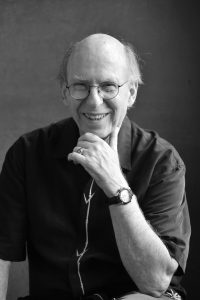
Image courtesy Bend Design Conference.
Please join us for a Memorial Celebration for Professor Victor Margolin during the 2020 Annual Conference on February 12, 2020.
Memorial Celebration for Professor Victor Margolin
Wednesday, February 12, 2020
5:30-7:30 pm
Resident’s Dining Room
Jane Addams Hull House
800 S. Halsted Street
Chicago, Illinois
If you’d like to attend, please RSVP to Rebecca Houze: rhouze@niu.edu
Victor Margolin (1941-2019) was Professor Emeritus of Design History at the University of Illinois at Chicago. He served on the CAA Board of Directors from 1993 to 1997 and was a frequent presenter and session chair at CAA’s Annual Conferences. He promoted the study of design and design history by encouraging the work of others and contributing to the activities of the Design Studies Forum. He was honored with Lifetime Achievement Awards for design research from LearnXDesign (2015) and the Design Research Society (2016). Victor was a founding editor of the academic design journal Design Issues. Books that he has written, edited, or co-edited include The Struggle for Utopia: Rodchencko, Lissitzky, Moholy-Nagy, 1917-1936; Design Discourse; The Designed World: Images, Objects, Environments; and The Politics of the Artificial: Essays on Design and Design Studies. He also edited and co-edited important volumes of essays on design titled Design Discourse (1989), The Idea of Design (1995) Discovering Design (1995) and The Designed World: Images, Objects, Environments (2002). The first two volumes of his World History of Design were published in April 2015.
In the words of his colleague and co-editor Bruce Brown, “Victor was a man of immense intellectual generosity and he mentored scholars young and old around the world. He was always a reasoned advocate of design as a tool to create societies that were more just, equitable and compassionate. These values were accompanied by a keen mind and twinkling eye that drew Victor to people all over the world. His deep humanity, ideas and insights will live on through books and essays to inspire future generations of designers.”
The Jane Addams Hull-House Museum is located on the campus of the University of Illinois at Chicago, 800 S. Halsted Street, Chicago. It is easily reached by public transportation using the UIC Halsted stop on the Blue Line or the Halsted Bus (#8), or via the Eisenhower Expressway (I-290) and the Dan Ryan Expressway (I-90). Parking is available at the Halsted and Taylor Street garage.
CAA Mourns the Loss of Jack Hyland, its Long-time Treasurer and Friend
posted by CAA — August 15, 2017
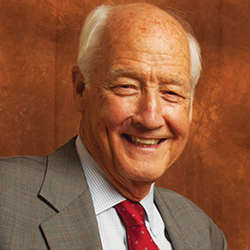 Jack Hyland, CAA’s treasurer and close advisor for over 30 years, passed away suddenly on Friday, August 11, 2017. The CAA staff, board, and committees are saddened by this monumental loss. Hyland began his career in investment banking at major financial services firms, including Morgan Stanley, Warburg Paribas Becker, and PaineWebber/Young & Rubicam Ventures. In 2010, he founded Media Advisory Partners with several partners. Hyland was a strident advocate for CAA, ensuring the financial health of the organization and guiding it with sound input and wisdom through three decades.
Jack Hyland, CAA’s treasurer and close advisor for over 30 years, passed away suddenly on Friday, August 11, 2017. The CAA staff, board, and committees are saddened by this monumental loss. Hyland began his career in investment banking at major financial services firms, including Morgan Stanley, Warburg Paribas Becker, and PaineWebber/Young & Rubicam Ventures. In 2010, he founded Media Advisory Partners with several partners. Hyland was a strident advocate for CAA, ensuring the financial health of the organization and guiding it with sound input and wisdom through three decades.
Hyland was the author of two notable books, Evangelism’s First Modern Media Star, The Life of Reverend Bill Stidger and The Moses Virus. In the former title, Hyland examined the life of his grandfather, the famous preacher, Bill Stidger, who foresaw the possibilities of modern-day media to expand evangelical work. His second book, The Moses Virus, is a fictional thriller set in Rome.
Hyland was born in 1938 in Detroit, Michigan. He majored in Theoretical Physics at Williams College, graduating in 1959; and from Harvard Business School, graduating in 1961.
In addition to serving CAA, Hyland was Co-Chair of the Board of Trustees of Teachers College, Columbia University. He was also Chairman Emeritus of the American Academy in Rome; and Vice President and Director of the Sterling and Francine Clark Art Institute. Formerly, he was also a Trustee and Treasurer of the National Building Museum in Washington.
We offer our condolences to his partner, Larry Wente; to his former wife, Karen Conant Hyland; to his children, Liza, Jonathan and Susannah, and grandchildren.


